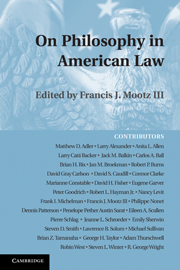Book contents
- Frontmatter
- Contents
- Introduction
- PART I KARL LLEWELLYN AND THE COURSE OF PHILOSOPHY IN AMERICAN LAW
- 1 On Philosophy in American Law (1934)
- 2 Law in Life, Life in Law: Llewellyn's Legal Realism Revisited
- 3 On Realism's Own “Hangover” of Natural Law Philosophy: Llewellyn Avec Dooyeweerd
- 4 On the Instrumental View of Law in American Legal Culture
- 5 When Things Went Terribly, Terribly Wrong
- 6 The Mechanics of Perfection: Philosophy, Theology, and the Foundations of American Law
- PART II PHILOSOPHICAL PERSPECTIVES ON LAW
- PART III AREAS OF PHILOSOPHY AND THEIR RELATIONSHIP TO LAW
- PART IV PHILOSOPHICAL EXAMINATIONS OF LEGAL ISSUES
- PART V LAW, RHETORIC, AND PRACTICE THEORY
- PART VI QUESTIONING THE RELATIONSHIP BETWEEN PHILOSOPHY AND AMERICAN LAW
- PART VII COMMENTARIES
- Contributors and Selected Bibliography
- Name Index
- References
3 - On Realism's Own “Hangover” of Natural Law Philosophy: Llewellyn Avec Dooyeweerd
Published online by Cambridge University Press: 31 July 2009
- Frontmatter
- Contents
- Introduction
- PART I KARL LLEWELLYN AND THE COURSE OF PHILOSOPHY IN AMERICAN LAW
- 1 On Philosophy in American Law (1934)
- 2 Law in Life, Life in Law: Llewellyn's Legal Realism Revisited
- 3 On Realism's Own “Hangover” of Natural Law Philosophy: Llewellyn Avec Dooyeweerd
- 4 On the Instrumental View of Law in American Legal Culture
- 5 When Things Went Terribly, Terribly Wrong
- 6 The Mechanics of Perfection: Philosophy, Theology, and the Foundations of American Law
- PART II PHILOSOPHICAL PERSPECTIVES ON LAW
- PART III AREAS OF PHILOSOPHY AND THEIR RELATIONSHIP TO LAW
- PART IV PHILOSOPHICAL EXAMINATIONS OF LEGAL ISSUES
- PART V LAW, RHETORIC, AND PRACTICE THEORY
- PART VI QUESTIONING THE RELATIONSHIP BETWEEN PHILOSOPHY AND AMERICAN LAW
- PART VII COMMENTARIES
- Contributors and Selected Bibliography
- Name Index
- References
Summary
“Ever since the era of the Legal Realists (such as … Karl Llewellyn),” remarks Litowitz (1997: 164), “lawyers have been aware that legal outcomes are somewhat indeterminate and unpredictable.” Hence the saying, “We're all realists now.” Then there was the joke among some law professors at the annual meeting of the American Association of Law Schools following the U.S. Supreme Court's handling of Bush v. Gore – which seemingly confirmed that law is politics (the slogan of critical legal studies) – that “we're all crits now.” But Karl Llewellyn, describing in 1934 the state of philosophy in American law, identified a sense in which we were, and I believe still are, all natural lawyers. (It is only a sense, because we are obviously not all formal adherents of the natural law tradition, any more than we are all realists or “crits.” But natural law, in a sense, is the fallback position for all of us.) And that sense on Llewellyn's part provides an unlikely link to a contemporary of Llewellyn (1893–1962), the Dutch legal theorist Herman Dooyeweerd (1894–1977) – unlikely, because Dooyeweerd was no realist, but rather a neo-Calvinist natural lawyer.
Dooyeweerd, like Llewellyn, was trained in law, not philosophy, but he became a leading philosopher in the Netherlands. As Llewellyn (1934) was writing “On Philosophy in American Law,” Dooyeweerd was completing De wijsbegeerte der wetsidee (The Philosophy of the Law-Idea) (Dooyeweerd 1935–6), which was translated into English as A New Critique of Theoretical Thought (Dooyeweerd 1953–8).
- Type
- Chapter
- Information
- On Philosophy in American Law , pp. 19 - 26Publisher: Cambridge University PressPrint publication year: 2009
References
- 2
- Cited by

